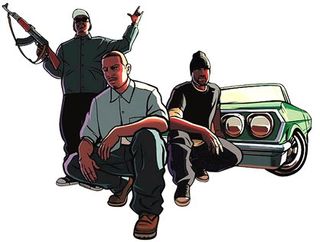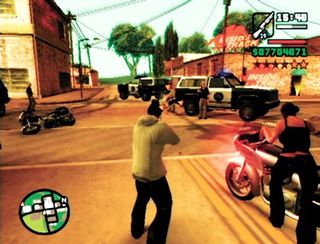Grand Theft Auto: San Andreas
PS2 / PC / Xbox / October 2004

San Andreas was the big one. And in so many ways. This expanded the GTA idea from a city to a state, introducing countryside for the first time to a game that, in all other respects, was the very definition of ‘urban’. And while all the familiar elements - do-anything chaos, Hollywood voices, gritty stories, action movie physics - were there, San Andreas expanded on seemingly every element to a nearly insane degree.
Certain elements are reworked for every GTA, and SA was no exception. Dual wielding debuted and targeting was improved again, inspired by another Rockstar game, Manhunt, with some of that title’s stealth elements coming along too - donning a mask let you creep into certain houses at night and rob them. Melee combat was hugely expanded, with extra moves available for those who trained in the gym. And, at last, you could swim.

Driving physics and car explosions were brushed up, and for the first time you could tune and customize cars, even adding hydraulics or nitrous. If your car was big enough you could also recruit a three-homie gang to help out with drive-bys, while it was even possible to respond (either positively or negatively) to the comments of passing pedestrians. Their responses would be influenced by another new feature, your character CJ’s evolving look - unlike previous characters, he could gain or lose weight, get stronger, become more adept at skills such as swimming, driving or cycling and change his hair, jewelry, tattoos and clothes. San Andreas was a whole lifestyle.
Opposing gangs have attacked players on sight since GTA 2, but for San Andreas this was expanded - CJ could take control of areas of ‘turf’ by provoking a gang war and surviving the waves of gangbangers until everyone was dead. The flipside was that rival gangs attacked CJ’s turf while he was elsewhere, requiring some tiresome commuting to deal with the threats - the answer was to take control of every bit of turf (not that there’s much grass in all that concrete) and leave no base for any other gang to attack from.

And of course, there was more here than just new cars. BMXs and mountain bikes joined a wider roster of motorcycles, while air travel expanded to include everything from light aircraft to private jets to freight transporters… to military fighters to huge helicopters to jetpacks. You could even buy a ticket for a commercial airliner, or take a ride on the train. Or just steal the train.

With such a vast space - each of the three cities was around the size of Vice City, while the often spooky, hillbilly-filled countryside covered the same sort of area again - there was inevitably a vastly increased amount of hidden, unique or just plain weird things within it. There was also a hugely expanded amount of things to do in San Fierro, Los Santos and Las Venturas when you weren’t on a mission. Go gambling, dancing, play pool, train in the gym, commit burglary, enter sports events, bet on horses, race mountain bikes or build a property portfolio… there was more to do just living in San Andreas than many games offer full stop.

San Andreas really brought Rockstar full circle. Rockstar’s key players had long been in love with the rap scene. San Andreas was their homage to it, to the early 1990s, the gangsters and ghettos. If there was a criticism, however, it’s that the first five hours or so are consequently grim - the cartoonish, Die Hard-style action takes a back seat to Boyz ‘N The Hood poverty, squalor, bickering, drug abuse and egotism. It’s hard to like the cast. And after a gorgeously silly middle section that includes jetpacks, alien conspiracy nuts and giant chickens, San Andreas returns to the theme of idiocy, misery and squalor with a crack house-set finale. If nothing else, it does make it clear that GTA is very much an adult game for adults.
